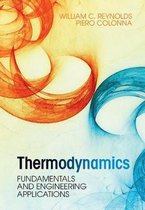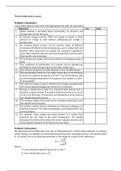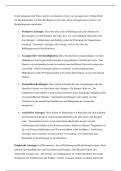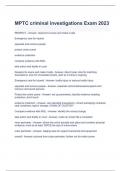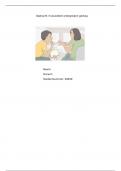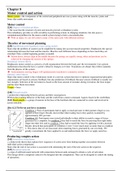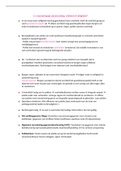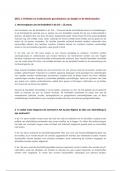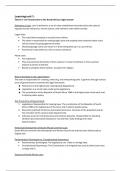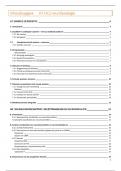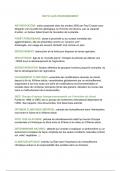Thermodynamics exam
Problem 1 (10 points)
True or false exercise (mark with X the appropriate box after the statement).
Statement True False
1. While heating a saturated liquid isochorically, its pressure and
temperature remain the same.
2. A thermal energy reservoir (TER) can supply or absorb a finite
amount of energy as heat without undergoing any change in
temperature.
3. An isolated system consists of two volumes made of different
materials with different initial temperatures, and in contact with one
another. After some time, the system has reached an equilibrium
state. Both materials have the same final temperature and the same
final specific internal energy.
4. A thermodynamic engine can function without discharging energy as
heat.
5. The coefficient of performance of a system can be obtained by
dividing the useful energy output by the total energy input.
6. Any intensive property of matter depends on the considered mass.
7. The specifications sheet of a car engine shows that its net efficiency
is 45% at an ambient temperature of 23℃. Your friend Jeremy tells
you that the peak temperature of the gases in the cylinders is 230℃.
Is this possible?
8. The internal energy of a gas is related to the energy associated with
the microscopically disorganized motion of its molecules.
9. Energy is transferred as heat to a saturated fluid mixture that is
stored in a rigid container. The quality of the initial state is 0.2, and it
is 0.8 in the final state. The pressure and temperature of the fluid do
not change during the process.
10. The entropy change of any fluid can be evaluated analytically if only
the specific heats are given.
11. An isolated control volume containing an ideal gas undergoes an
isothermal process. No internal energy gets accumulated within the
control volume.
12. An adiabatic mixer merges two equal streams of a certain fluid
entering into the mixer at the same temperature. The specific
entropy of the fluid at the outlet of the mixer is greater than the sum
of the specific entropies of the fluid at the two inlets.
Problem 2 (10 points)
Non-dimensional quantities play a key role in thermodynamics, as they allow engineers to compare
similar systems. An example of a dimensionless quantity used in pumping systems is the specific speed
𝑁𝑠 of a pump. This is an important parameter in the design of a pump, and is defined as:
𝑁√𝑄
𝑁𝑠 = 3
(𝑔𝐻)4
Where:
- 𝑁 is the rotational speed of the pump, in 𝑟𝑎𝑑/𝑠.
𝑚3
- 𝑄 is the volume flow rate, in 𝑠
.
, 𝑚
- 𝑔 is the gravitational acceleration, in 𝑠2 .
- 𝐻 is the head of the pump, in 𝑚.
a) Prove that the specific speed is a dimensionless quantity (clearly show your working).
b) Calculate the specific speed of the liquid oxygen (LOX) pump used in the SpaceX Raptor Engine,
given the following information:
𝑚
- 𝑔 = 9.81 𝑠2
𝑔𝑎𝑙
- 𝑄 = 346000 ℎ𝑟
- 𝑁 = 14000 𝑟𝑝𝑚
- 𝐻 = 7250 𝑓𝑡
Use the following unit conversions:
- 1 𝑓𝑡 = 0.3048 𝑚
- 1 𝑔𝑎𝑙 = 0.00379 𝑚3
Problem 3 (15 points)
An ideal gas is heated in a piston cylinder system where the piston is able to move freely. The system
has a circular cross-section with radius 𝑟 and the surrounding environment is at sea-level atmospheric
conditions. The mass of the piston can be considered negligible. Obtain an expression for the change
in piston head position as a function of the amount of energy transferred as heat, the pressure, the
isochoric specific heat 𝑐𝑣 , the gas constant 𝑅, and the radius 𝑟.
Problem 4 (20 points)
A constant volume vessel of 20 liters holds 2 kg of oxygen in thermodynamic equilibrium at an initial
temperature of 102 K. The vessel is heated until there is only saturated vapor oxygen.
a) Determine the temperature and pressure once the oxygen has reached its final equilibrium
state.
b) Determine the amount of energy transferred as heat for this process.
c) Sketch the process on the provided P-h diagram for oxygen.
Problem 1 (10 points)
True or false exercise (mark with X the appropriate box after the statement).
Statement True False
1. While heating a saturated liquid isochorically, its pressure and
temperature remain the same.
2. A thermal energy reservoir (TER) can supply or absorb a finite
amount of energy as heat without undergoing any change in
temperature.
3. An isolated system consists of two volumes made of different
materials with different initial temperatures, and in contact with one
another. After some time, the system has reached an equilibrium
state. Both materials have the same final temperature and the same
final specific internal energy.
4. A thermodynamic engine can function without discharging energy as
heat.
5. The coefficient of performance of a system can be obtained by
dividing the useful energy output by the total energy input.
6. Any intensive property of matter depends on the considered mass.
7. The specifications sheet of a car engine shows that its net efficiency
is 45% at an ambient temperature of 23℃. Your friend Jeremy tells
you that the peak temperature of the gases in the cylinders is 230℃.
Is this possible?
8. The internal energy of a gas is related to the energy associated with
the microscopically disorganized motion of its molecules.
9. Energy is transferred as heat to a saturated fluid mixture that is
stored in a rigid container. The quality of the initial state is 0.2, and it
is 0.8 in the final state. The pressure and temperature of the fluid do
not change during the process.
10. The entropy change of any fluid can be evaluated analytically if only
the specific heats are given.
11. An isolated control volume containing an ideal gas undergoes an
isothermal process. No internal energy gets accumulated within the
control volume.
12. An adiabatic mixer merges two equal streams of a certain fluid
entering into the mixer at the same temperature. The specific
entropy of the fluid at the outlet of the mixer is greater than the sum
of the specific entropies of the fluid at the two inlets.
Problem 2 (10 points)
Non-dimensional quantities play a key role in thermodynamics, as they allow engineers to compare
similar systems. An example of a dimensionless quantity used in pumping systems is the specific speed
𝑁𝑠 of a pump. This is an important parameter in the design of a pump, and is defined as:
𝑁√𝑄
𝑁𝑠 = 3
(𝑔𝐻)4
Where:
- 𝑁 is the rotational speed of the pump, in 𝑟𝑎𝑑/𝑠.
𝑚3
- 𝑄 is the volume flow rate, in 𝑠
.
, 𝑚
- 𝑔 is the gravitational acceleration, in 𝑠2 .
- 𝐻 is the head of the pump, in 𝑚.
a) Prove that the specific speed is a dimensionless quantity (clearly show your working).
b) Calculate the specific speed of the liquid oxygen (LOX) pump used in the SpaceX Raptor Engine,
given the following information:
𝑚
- 𝑔 = 9.81 𝑠2
𝑔𝑎𝑙
- 𝑄 = 346000 ℎ𝑟
- 𝑁 = 14000 𝑟𝑝𝑚
- 𝐻 = 7250 𝑓𝑡
Use the following unit conversions:
- 1 𝑓𝑡 = 0.3048 𝑚
- 1 𝑔𝑎𝑙 = 0.00379 𝑚3
Problem 3 (15 points)
An ideal gas is heated in a piston cylinder system where the piston is able to move freely. The system
has a circular cross-section with radius 𝑟 and the surrounding environment is at sea-level atmospheric
conditions. The mass of the piston can be considered negligible. Obtain an expression for the change
in piston head position as a function of the amount of energy transferred as heat, the pressure, the
isochoric specific heat 𝑐𝑣 , the gas constant 𝑅, and the radius 𝑟.
Problem 4 (20 points)
A constant volume vessel of 20 liters holds 2 kg of oxygen in thermodynamic equilibrium at an initial
temperature of 102 K. The vessel is heated until there is only saturated vapor oxygen.
a) Determine the temperature and pressure once the oxygen has reached its final equilibrium
state.
b) Determine the amount of energy transferred as heat for this process.
c) Sketch the process on the provided P-h diagram for oxygen.

